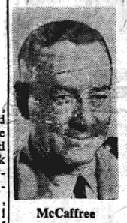| Washington, April 27 (AP) - The USS Hobson, a destroyer-
minesweeper collided with the famous
carrier Wasp last night,
and plunged to the bottom in mid-Atlantic. The Navy said that
176 men were reported missing, including the craft's skipper.
Sixty-one men were snatched to safety out of a windy, rolling
sea.
In Charleston, S.C., Rear Admiral
William V. O'Regan, minesweeper
commander at the home base of the
Hobson, said there had been 237 men
aboard the ship.
7 Officers Lost
In Washington, the Bureau of
Naval Personnel casualty section said
it was preparing "reported missing"
telegrams for families of 176 men, including seven officers and 169 en-
listed personnel.
The captain of the Hobson was 31-
year old Lieut. Comdr. William J.
Tierney of Philadelphia. He had risen
from the ranks and won his commission in 1941.
Full details of the accident were
not immediately given by Naval authorities.
Earlier in the afternoon Navy headquarters said rescue operations
were still on.
That was nearly
a full day after
the mid-ocean
smashup in the
wind-lashed darkness. The Wasp's
bow was damaged in the collision. The accident was one of
the great noncombat disasters
the Navy has suffered in recent times.
On February 18, 1942, the USS
Truxton, a destroyer, and the Pollux,
a cargo ship, were lost in a storm off
Newfoundland with 204 dead.
On April 19, 1942, 218 lives were
lost when the destroyer Ingraham was
involved in an Atlantic collision.
Weather is Bad
Hobson rescue efforts were
hampered by the dark, and by foul
weather. A navy dispatch reported
that at 2:00 a.m. (EST) winds were "15
knots southwest, sea rough and confused." That weather report came
nearly 5 hours after the crash.
The Wasp suffer a slashing rip
for 75 feet along her bow plates,
the Navy reported. She was headed
for New York at reduced speed ten knots. There were no casualties reported aboard the big carrier.
Fleet headquarters spotted the scene
of the collision as 1,200 miles due
east of Boston and 700 miles from the
Azores.
The time of the crash was given as
1:25 a.m.Sunday, Greenwich Time,
which would be 8:25 p.m. Saturday,
EST. The spot being well west of the
Azores, the theoretic time at the
scene was before midnight.
The Wasp was on the way to take
up a station in the Mediterranean
when she collided with the Hobson
at latitude 42 degrees 21 minutes
north, longitude 44 degrees 15 minutes west.
Two Ships In Rear
It was announced that the collision
occurred when the Wasp turned into the
wind to recover aircraft which were
returning from a simulated night strike
against other ships in the task
group, en route to the Mediterranean.
The Hobson and another destroyer
minsweeper, the Rodman, were trailing the Wasp in plane guard stations
- meaning they were a little to the
rear in position to pick up men in the
event any of the planes were ditched
in attempting to land.
The skipper of the Wasp is Capt.
B. C. McCaffree. Commanding the
Hobson was Lieut. Comdr. W. J.
Tierney .

Palau Also in Group
The task group also included the carrier
Palau, the cruisers Worchester and
Baltimore, the fleet oiler Pawcatuck,
two submarines and 15 destroyers of
Destroyer Flotilla No. 4.
The task group is under the command of Rear Admiral H.B. Jarrett,
who was aboard the Worchester. The
destroyer flotilla is commanded by
Rear Admiral C.C. Wood.
The Hobson was hit on the starboard (right) side. The Navy said it
had no information as to how long
she stayed afloat.
______________________
|

